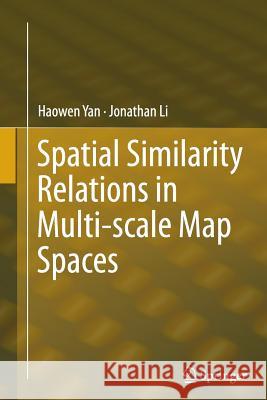Spatial Similarity Relations in Multi-Scale Map Spaces » książka



Spatial Similarity Relations in Multi-Scale Map Spaces
ISBN-13: 9783319383262 / Angielski / Miękka / 2016 / 188 str.
Spatial Similarity Relations in Multi-Scale Map Spaces
ISBN-13: 9783319383262 / Angielski / Miękka / 2016 / 188 str.
(netto: 486,09 VAT: 5%)
Najniższa cena z 30 dni: 506,04
ok. 10-14 dni roboczych
Bez gwarancji dostawy przed świętami
Darmowa dostawa!
This book aims at the theory of spatial similarity relations and its application in automated map generalization, including the definitions, classification and features of spatial similarity relations.
Preface.- Introduction.- Background and Motivation.- Significances of Spatial Similarity Relations.- Theory of Spatial Relations.- Spatial Description, Spatial Reasoning and Spatial Query/Retrieval.- Spatial Recognition.- Automated Map Generalization.- Classification of Objects in Multi-scale Map Spaces.- Definitions of Map Scale Change.- Research Objectives.- Scope of the Study.- Book Outline.- Literature Review and Analysis.- Definitions of Similarity.- Definitions of Similarity in Various Fields.- Critical Analysis of the Definitions.- Features of Similarity.- Features of Similarity in Different Fields.- Critical Analysis of the Features.- Classification for Spatial Similarity Relations.- Calculation Models/Measures for Similarity Degree.- Models in Psychology.- Models/measures in Computer Science.- Models/measures in Music.- Models/measures in Geography.- Critical Analyses of Existing Models/Measures.- Raster-based Approaches for Map Similarity Comparison.- Per Category Comparison Method.- Kappa Comparison Method.- Fuzzy Kappa Approach.- Fuzzy Inference System.- Fuzzy Comparison with Unequal Resolutions.- Aggregated Cells.- Moving Window-based Structure.- Numerical Comparison Methods.- Chapter Summary.- Concepts of Spatial Similarity Relations in Multi-scale Map Spaces.- Definitions.- Definitions of Similarity Relation.- Definitions of Spatial Similarity Relation.- Definitions of Spatial Similarity Relation in Multi-scale Map Spaces.- Definition of Difference.- Features.- Equality.- Finiteness.- Minimality.- Auto-similarity.- Symmetry (Reflectivity).- Non-transitivity.- Weak Symmetry.- Asymmetry.- Triangle Inequality.- Scale-dependence.- Factors in Similarity Judgments.- Factors for Individual Objects.- Factors for Object Groups.- Psychological Tests for Determining the Weights of the Factors.- Classification.- A Classification System of Spatial Similarity Relations in Geographic Spaces.- A Classification System of Spatial Similarity Relations on Line Maps.- Chapter Summary.- Models for Calculating Spatial Similarity Degrees in Multi-scale Map Spaces.- Models for Individual Objects.- Model for Individual Point Objects.- Model for Individual Linear Objects.- Model for Individual Areal Objects.- Models for Object Groups.- Model for Point Clouds.- Model for Parallel Line Clusters.- Model for Intersected Line Networks.- Model for Tree-like Networks.- Model for Discrete Polygon Groups.- Model for Connected Polygon Groups.- Model for Calculating Spatial Similarity Degrees between Maps.- Similarity in Topological Relations.- Similarity in Direction Relations.- Similarity in Metric Distance Relations.- Similarity in Attributes.- Chapter Summary.- Model Validations.- General Approaches to Model Validation.- Strategies for Validating The New Models.- Psychological Experiment Design.- Samples in Psychological Experiments.- Rules Obeyed in Sample Selection.- Samples Used.- Statistical Analysis and Discussion.- Chapter Summary.- Applications of Spatial Similarity Relations in Map Generalization.- Relations between Map Scale Change and Spatial Similarity Degree.- Description of the Problem.- Conceptual Framework for Solving the Problem.- Formulae for Map Scale Change and Spatial Similarity Degree.- Individual Point Objects.- Individual Linear Objects.- Individual Areal Objects.- Point Clouds.- Parallel Line Clusters.- Intersected Line Networks.- Tree-like Networks.- Discrete Polygon Groups.- Connected Polygon Groups.- Maps.- Discussion about the Formulae.- Approach to Automatically Terminate a Procedure in Map Generalization.- Calculation of the Distance Tolerance in the Douglas-Peucker Algorithm.- The Douglas-Peucker Algorithm and Its Disadvantages.- Approach to Calculating the Distance Tolerance for the Douglas-Peucker Algorithm.- An Example for Testing the Approach.-Chapter Summary.- Conclusions.- Overall Summary.- Contributions.- Limitations.- Recommendations for Further Research
Appendix A - List of Basic Logic Symbols
Dr. Haowen Yan obtained his Bachelor’s, Master’s, and Doctor’s degrees in Cartography and Geographic Information Engineering from Wuhan University, China. He has worked at the Hong Kong Polytechnic University as a research assistant, at the University of Zurich as a senior researcher, and at the University of Waterloo as a research fellow. He is currently a visiting professor at the University of Waterloo and professor of Geomatics in the Lanzhou Jiaotong University, China.
Jonathan Li is a professor at the Department of Geography and Environmental Management at the University of Waterloo. Dr. Li's research interests are mainly in the areas of remote sensing and geographic information science, including high-resolution satellite mapping, airborne and terrestrial mobile LIDAR mapping, earth observation of global change, remote sensing of inland and coastal waters, remote sensing of renewable energy potential, mapping of climate-induced hazards, Internet GIS and Web Mapping, Terrain Analysis in Hydrogeography, geospatial sensor network, and geospatial information technologies for emergency response and disaster management.
How does one determine how similar two maps are? This book aims at the theory of spatial similarity relations and its application in automated map generalization, including the definitions, classification and features of spatial similarity relations. Included also are calculation models of spatial similarity relations between arbitrary individual objects and between arbitrary object groups, and the application of the theory in the automation of the algorithms and procedures in map generalization.
1997-2025 DolnySlask.com Agencja Internetowa
KrainaKsiazek.PL - Księgarnia Internetowa









